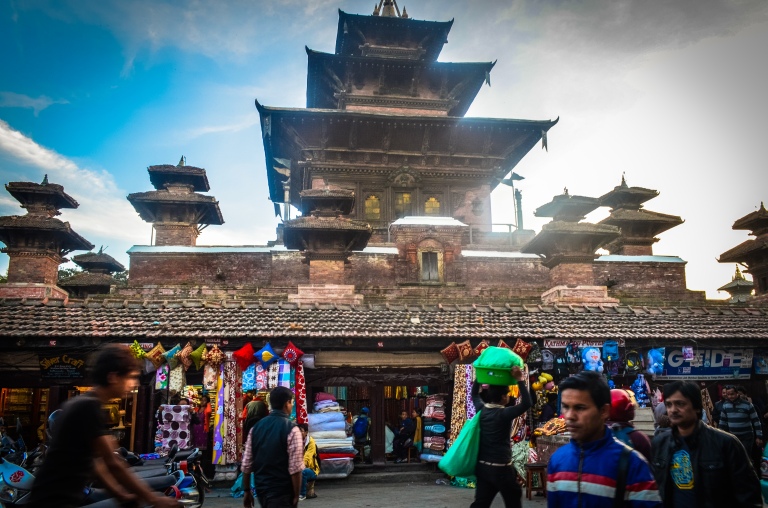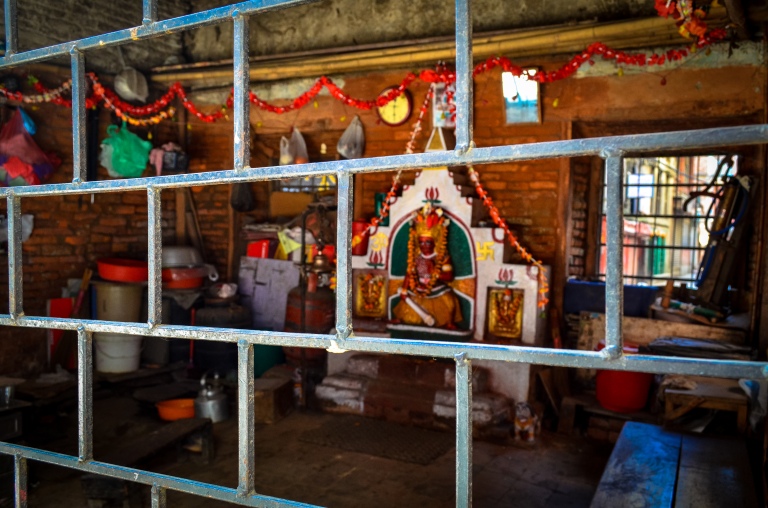I opened one eye as a glint of sun peeked through the window at Hotel Buddha Land. Thanks to some serious jet-lag, I was completely awake before the 7 o’ clock hour. This is something I actually love about jet-lag. Your body operates on an erratic clock, where you find yourself curling up in the early evening, then stirring around 2 or 3 a.m. and subsequently staring at, depending on where you are, either a barren wall or probably Facebook, only to return to sleep until 6 or 7 a.m. Sure, it sounds exhausting but when you’re traveling there’s no time to sleep in.

My mind churned with tasks to complete before meeting our guide and jumping on a bus at 11 a.m. to the village of Dhunche, where our trek would begin. On the ‘To do’ list was finding an ATM that didn’t charge an astronomical fee so we could pay the guide company, buying gloves (somehow I forgot to pack this crucial item), finding a puffy jacket for Jess (somehow she forgot to pack this crucial item), candy to refresh our dry mouths at high altitudes, water, snacks, toilet paper, and… I think that’s it? Jess and I dressed quickly and headed downstairs for breakfast in the small sunlit dining room. Each morning the hotel’s staff, including a young boy about 10 years old, served up eggs, boiled potatoes and toast to a panel of international guests. Tang (no thanks), coffee (yes for Jess) and Nepali tea made with powdered milk and sugar (yes for me) were also on the menu.
The streets of Thamel – the trendy backpacker enclave of Kathmandu – were just beginning to oscillate as store owners, pedaling handmade wool sweaters and hats, religious trinkets, silver and turquoise earrings, gaudy beaded necklaces, alpaca scarves, oil paintings, and knock-off North Face and Pataguchi, solicited potential customers, mustering their best English phrases: “Hello, welcome please. I have great deal for you!”


Meanwhile, motorists began to engage in horn cacophony (something Jess and I were unraveling at the seams from). Even in the morning, the utter congestion of Kathmandu’s soggy streets happens very quickly: cars, bikes, motorcycles, rickshaws and pedestrians all competing for a small patch of gravel. If you’re smart, you’ll don a mask over your nose and mouth – like many of the locals – to protect your lungs from the intense smog that envelopes the air. Though among all the congestion and pollution, there exist quiet side streets seemingly immune to Kathmandu’s widespread problems. It is on these avenues people reflect in tiny hidden temples while plumes of incense conceal the polluted atmosphere.

After some cutthroat bartering, Jess acquired a $10 turquoise ‘North Face’ puffy jacket (its authenticity is surely questionable). And at the very same shop I bought Thinsulate gloves for about $2 (authenticity is also doubtful but they warmed my hands all winter…up until those holes in the middle and index fingers).
The shopping was far easier than finding an affordable ATM. We combed the streets as the clock ticked and even stopped in a Nepali bank, which was mostly bare except for a few desks, one teller, and multiple guards all holding AK-47s.

We found the golden ATM just in time and scurried back to our hotel to collect our belongings. But when we arrived at Hotel Buddha Land, there was a message for us to call Anu.
Apparently the bus schedule had changed because of the upcoming holiday, Diwali, and we had missed the last bus of the day to Dhunche. Alarms were already sounding in my head. Anu asked us to come to her office to discuss our options, which included either taking a bus to this “very nice, touristic town,” about halfway to Dhunche, spending the night and leaving on the first bus out, or staying in Kathmandu another night and trying for tomorrow. “It’s my fault,” Anu admitted, “So I’ll pay for a hotel… but not the one you are staying at. That one… too much.” (Now make no mistake, dear reader, we cannot afford posh accomodations–Hotel Buddha Land costs about $25 a night, which isn’t crazy by American standards but by Nepali standards, that’s an expensive joint.) Jess and I decided to take advantage of the opportunity to see another part of Nepal. Just then, we had the pleasure of meeting our guide, Bimala. We said “Namaste” to a short, pudgy woman in her mid-20s outfitted in a wool sparkly turtleneck, wool dress pants, and bare feet. All that she had with her was a tiny Jansport backpack. It resembled what a kindergartener might bring to school. Now, none of this would matter if she wasn’t an alleged mountain guide, whom we were paying to trek with (because we’d been advised we HAD to trek with a guide). But since she was, we expected a little more in the departments of fitness, preparedness and perceived capability. Whatever. Let’s get going.
As we coasted over steep cliffs in a vehicle the size of a VW bus, my ears popping as we gained elevation, I couldn’t shake Phil’s words: “More people die in bus accidents in Nepal than from anything else. You’re best off sitting on the roof of the bus, that way, when it tips over, you can jump off, and maybe save yourself.” While the idea of dying in a bus crash in Nepal was mildly upsetting, sitting on the rooftop of a bus and having to jump off as it tumbles down a cliff was just a little more horrifying. I gazed out the window and tried to concentrate on the majestic snow-capped Himalayas, which were finally visible and completely breathtaking. When the mini bus stopped, I thought we were taking another bathroom break as this particular town was a veritable trash dump. There were mounds of trash lining what used to be a spectacular part of the Tirsuli River, and trash heaps dominated the streets, along with emaciated dogs and pissed-off children. Oh, did you want to see some pictures?



As we exited the bus, while enduring ample stares from local eyes, I quickly realized we had been ill advised. There were only about four or five guest houses in the entire “touristic” town of Tirsuli and each one was host to more bugs, filth and critters than humans. The first guest house we checked out had a bathroom en suite…with a squat toilet coated in urine and other mysterious foul-smelling liquids. The beds were made with tattered, stained blankets and the floors were crawling with a cornucopia of bugs. The next hotel was the same story… and the next one. We walked to the end of the street to check out one more place. A man and his son sprang into action after Bimiala spoke to them in Nepali – I imagined her saying: “Hey we got some picky-ass Americans here, can you clean up for these damn princesses?”
“They are going to make the room look nice for you to see,” Bimala explained. We hadn’t even agreed to stay the night, but just to make the room presentable, they spent a half hour in there. Scanning the concrete hotel, I noticed various plates of food sitting on display by a cash register. Among the items were some scorched chicken wings about to grow fur and petrified French fries.
The boy and his father looked pleased with their efforts as we followed them up a musty set of cement stairs. The room had two tiny beds, a dusty floor, stained walls and a vile bathroom. The lights didn’t work but there was at least a scummy bay window caked with years of grime and dead insects. We knew this was the end of the road. “OK, I guess we’ll stay here,” Jess and I agreed in a defeated tone.

That night, we gathered on the floor around a wooden table for dinner. The eerie silence paired well with the sooty, cobwebbed walls decorated with 80s posters of flowers and cartoons. There was no menu so Jess and I ordered a Nepali speciality: momos. I opted for vegetarian and Jess made the mistake of selecting chicken. She would deeply suffer – for ordering poultry in a place that clearly abided by no code of hygiene or cleanliness – during the bulk of our trek for her decision.
After a sleepless night in a creaky child’s bed, I was ready to get the hell out of Tirsuli. But at least I could leave; I thought about the locals living in trash town. It’s hard to point fingers when there is simply no infrastructure to support an increase in population, tourism and the use of plastics. Trash cans are virtually unheard of in Nepal, and when Kathmandu’s government tried to place them all over the city recently, the locals stole the plastic receptacles and melted them down for money.
Jess awoke to find that ants had invaded her backpack and were happily snacking on the nice German chocolate bar she had bought for the trek. We made the mistake of eating yet another meal at this dumpy cesspool before heading down the street to the bus ‘station.’ But when we arrived, all the busses were full. Bimala, of course, had not pre-arranged tickets for us. The alarms in my head were growing louder.
To be continued… 🙂
You are a wonderful storyteller, having me completely captivated in your treacherous Nepali adventureworld part two… only to leave me hanging on the edge of my seat once again!
Nice work 🙂
Love, your sister
Thank you! So happy to have captivated you!
“It can only get better from here…”
Well, look who it is, ladies and gentlemen! At least you all know the infamous Jess is still alive!
Love your stories! Riveted! They always leave me sighing at their brevity. Little jewels. This one had me at “cornucopia of bugs” – yum
Wow, thanks, robininjackson. I am thrilled to have entertained you with this tale. 🙂
I am drawn into your engaging yet mysterious tales, as much as if they were a part of the series “Lost.” You capture not only the landscape of your host country, but also its texture, smell and personality. It is obvious, the planet is your playground. Play on!!
Thank you, shweetay. The world is your playground, too. 😉
Robyn,
I love this blog. You have such great adventures to tell and tell them in such a captivating way! I want to hear part 2…
Erika! Thank you so much for taking the time to stop by and read my adventure tales! xoxo
Your real life adventures are the fiction and fantasies of most of our lives. I hope you will always travel and relate these exciting tales to us, but I trust that your spirit and wanderlust guarantee that. Be still my nomadic heart.
Thank you, AWD. I look forward to embarking on a new adventure with you in The City of Lights!